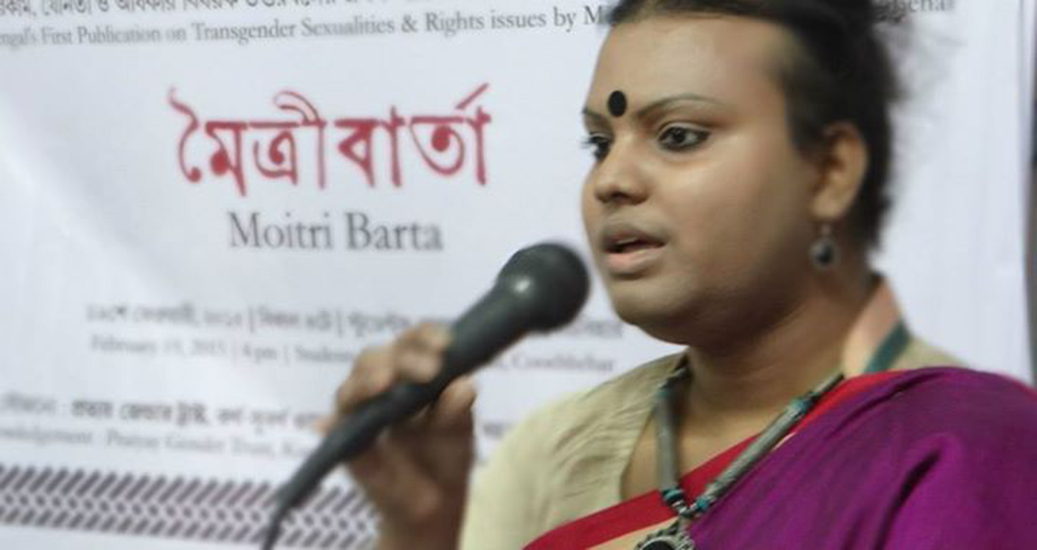Some of the most exciting work around gender in Bengal is being done by community-based organisations working in the hinterlands. So why are they being left out of the state’s transgender development board, asks Sayan Bhattacharya.
Ever since the Supreme Court upheld the right to gender expression in the NALSA verdict (National Legal Services Authority v Union of India and others) in April last year, transgender mobilisations across the country have started receiving the attention of various state governments, educational institutions as well as many corporate houses. While much of this attention has not translated into any substantial state-instituted welfare schemes for trans people, some universities have started opening up to different genders in their admission procedures; some private companies have started recruiting transgender individuals; there have been attempts in different sectors to understand gender beyond the binary. A private member’s bill for the rights of transgender people was recently passed by the Rajya Sabha. The bill will soon be tabled in the Lower House.
While we have had hijra legislators as well as hijras contesting elections before, these recent developments have brought conversations on gender expression firmly into the mainstream. In such a context, when one hears that the West Bengal government has instituted a Transgender Development Board, one feels extremely hopeful and buoyant about the outcomes of trans activism. Yet, the constitution of the board leaves much to be desired.
The announcement of the first batch of members of the board comes closely on the heels of a news story that made international headlines. Manobi Bandyopadhyay, who was one of the first few persons to have publicly spoken about her gender affirmation surgery in West Bengal, was appointed as the principal of Krishnanagar Women’s College. She is the first transgender person to be appointed to such a post in India. Within a few days of this development, she was announced as the vice chairperson of the Board.
While Manobi’s individual struggle and her eventual success is a story of sheer grit and it is indeed inspirational, the fact remains that she has never been involved with trans activism. In fact, she refused to identify as transgender until recently.
Although the idea of a visible trans face who hails from this very state would find her way onto the board seems a logical progression, her appointment does raise some very problematic questions, which were left unaddressed. All these questions are about the vexed politics of representation. First, when an invisibilised constituency finds a platform to raise its concerns, what is the criterion to select the voices that will represent it? Second, is there a homogeneity to that constituency?
While Manobi’s individual struggle and her eventual success is a story of sheer grit and it is indeed inspirational, the fact remains that she has never been involved with trans activism. In fact, she refused to identify as transgender until recently. She was not even present in any of the consultations that ultimately led up to the constitution of the Board. In news programme after programme, she has spoken about how the Supreme Court verdict is a “third gender verdict”, refusing to acknowledge that many trans individuals prefer to identify as ‘female’ or ‘male’, that there is a whole spectrum of people including post-operative ones, those who do not want surgical intervention, who refuse any gender category or who inhabit different genders at different points in time and so on—the Supreme Court judgment acknowledges every such expression! Yet Manobi has continuously tried to create false differences based on “trans authenticity”. So when such a voice becomes the Vice Chairperson of the Transgender Development Board, one wonders whether she will be able to do justice to her position. Is it her prominence on the international firmament that became the ticket to this post, or is it her well-known proximity to the ruling dispensation?
Though one could still find some logic in Manobi’s appointment to the Board, the presence of a Tollywood celebrity like Churni Ganguly on the board defies common sense. The only tenuous connection that one could draw is that she once acted in a telefilm about a lesbian couple (but then, why must one conflate gender and sexuality so simplistically?) and later acted in a feature film where the central character (played by the late Rituparno Ghosh) inhabited a somewhat gender-liminal space. But those were film roles! How does that prove her credibility to serve the transgender people of West Bengal? The same question can be raised about Leena Ganguly, a well-known script writer who is now on the Board.
These three names found space in media coverage thanks to their celebrity quotient as well as because the government announced these names formally. However, one could get news about the next set of appointments only through informal networks and status updates on Facebook, because there has been no formal announcement. Thankfully, activists from some bona fide community-based organisations, a queer feminist collective and an eminent person who helms a wealthy hijra gharana have found representation in the second lot, and it is therefore expected that they will bring their rich experience from the ground to the table, unlike the previous set of appointments.
Yet, there is a third layer to the problematic of the Transgender Development Board and that is about the very locational specificities of trans activisms. Sumi Das of Moitrisanjog Society, a community based group that has been working for the rights of hijras, kotis and transgender people in Cooch Behar district, says that groups from Nadia, Murshidabad, Cooch Behar and many other districts beyond the suburbs of Kolkata were not invited to the consultations that led to the formation of the board, convened by the Women and Child Welfare department of the West Bengal government. It was mostly groups from Kolkata and its suburbs and some groups working in the districts that receive funding from international donor bodies who were invited.
Moitrisanjog repeatedly emailed the convenor of the consultations to be included in future meetings, but received no response. Finally, having found out about a scheduled meeting—on 15 July 2014—from informal sources, Aniruddha Dutta, a research scholar who has worked with Moitrisanjog, Nadia-Ranaghat Sampriti and Sangram in Murshidabad, attended it. She spoke to the Shashi Panja, the minister of state (independent charge), and informed her about these groups and how they were being denied the right to attend these meetings. The government still made no efforts to reach out to them. Earlier this year, the three organisations wrote a joint deputation expressing their concerns and sent it to Panja.
The complete lack of formal and transparent communication on behalf of the government with most of the stakeholders that the board is supposed to initiate welfare measures for is an issue that should have triggered wide outrage from activist circles, but hasn’t.
However, that none of these interventions yielded any result was proven when the consultations gave way to the newly constituted Transgender Development Board last month. Neither these groups nor others outside greater Kolkata have found place in the board. Moreover, the process followed in selecting members hasn’t been disclosed either. So how democratic was the constitution of the Board? How representative is it of the entire trans spectrum?
While this is not to question the credibility of the community representatives who have made it onto the board, the complete lack of formal and transparent communication on behalf of the government with most of the stakeholders that the board is supposed to initiate welfare measures for is an issue that should have triggered wide outrage from activist circles, but hasn’t. Are Bengal’s rural towns, where some of the most exciting work around gender is happening—be it workshops, crisis intervention or legal consultation—despite daunting challenges, not important enough for such a crucial step forward for the transgender movements of the state? Are groups that are outside the net of funding networks destined to remain invisibilised? How, then, does one expect the voices from every corner of the margin to be reflected? Is the state at all serious about trans welfare, or is it just paying lip service to a Court verdict? While as a saving grace, there are still a few slots left to be filled on the Board, the question is whether the state will own up to its responsibility of delivering welfare and justice to the marginalised, even on the farthest corners of its map.














